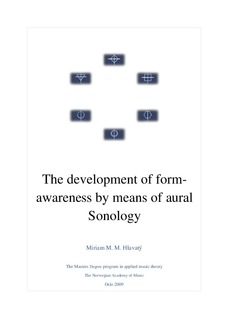The development of form-awareness by means of aural sonology
Master thesis
Permanent lenke
http://hdl.handle.net/11250/172485Utgivelsesdato
2009Metadata
Vis full innførselSamlinger
- Masteroppgaver [283]
Sammendrag
In this Master thesis I wish to examine the benefit that performance students and musicians can have from the ability to use aural sonological analysis as an aid in the approach and presentation of contemporary music to an audience. The original idea of this thesis was born from the personal experience of the chasm that often seems to exist between contemporary music and the audience with which it seeks to communicate. As a performer of contemporary music shamelessly dragging friends and family to listen to my concerts I was often intrigued by the lack of understanding and communication which sometimes occurred in the concert between music and audience despite the obvious willingness of the audience to understand. I became interested in the concert situation itself and if maybe the presentation of contemporary music demanded something particular in this situation.
Aural Sonology consists of an analytical system where the object of analysis is the aural aspect of music; music as heard as supposed to the written aspect (the score). The musical object experienced through listening will never be an objective fact like a score but will always change according to how we listen. Therefore the subject of listening intentions or listening behavior is central in aural sonology as a means to achieve a systematic approach to the object one is analyzing. The subject of listening intentions is also relevant when it comes to understanding what takes place in a concert situation because it helps to place the focus equally on the listener and the musician. The knowledge of the different listening behaviors we may encounter in an audience is an important knowledge for musicians who wish to work with the presentation of music of a more contemporary date (it may indeed be just as important a tool for the presentation of the traditional classical repertoire as well but that is not the topic of this thesis).
Beskrivelse
Norges musikkhøgskole. Masteroppgave. Anvendt musikkteori. - Den trykte versjonen har vedlagt lydfiler (CD) som pga rettighetsspørsmål ikke kan legges ut på nettet.
